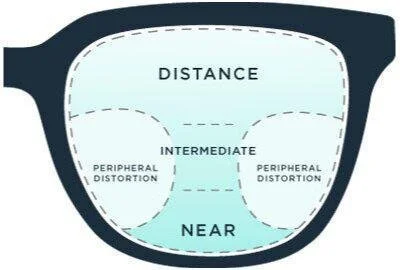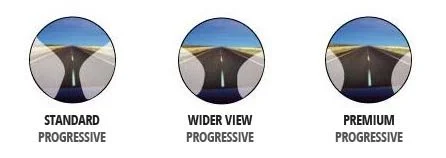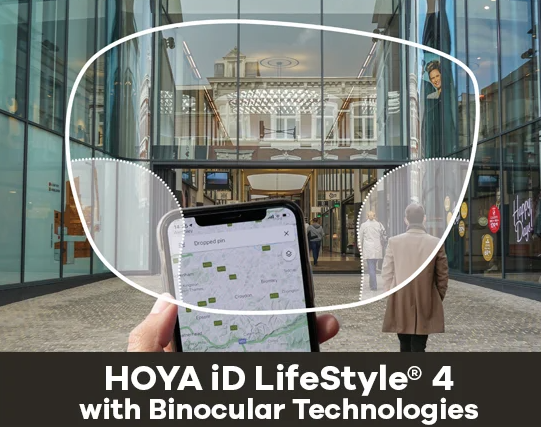Understanding Different Types of Progressive Lenses (And Why Prices Vary So Much)
If you've ever looked into getting progressive lenses, you’ve probably been hit with a little sticker shock, and a ton of options. Some lenses are around $100, while others can cost $800 or more. So what's the deal? Let’s break down the types of progressive lenses, what makes them different, and why the price tags can vary so wildly.
What Are Progressive Lenses?
Progressive lenses are a type of multifocal lens designed to correct vision at multiple distances (near, intermediate, and far) without the visible lines of bifocals or trifocals. The top of the lens helps you see far away, the middle for things like computer screens, and the bottom for reading.
Unlike traditional lenses, progressives have a gradual shift in prescription strength. This gives you a smoother, more natural visual experience. But the design and technology behind that smooth transition are what make things complicated.
Types of Progressive Lenses
1. Standard Progressive Lenses
Price Range: $100–$400
Best For: Budget-conscious users who wear them occasionally.
Pros: Affordable entry point to progressives.
Cons: Narrower field of vision, more distortion on the sides, longer adaptation period.
These lenses are based on older designs and may not be customized to your specific prescription or lifestyle. You'll likely experience a smaller clear vision area, and more peripheral blur.
2. Premium Digital Progressive Lenses
Price Range: $400–$600
Best For: People who wear glasses all day and want better comfort and clarity.
Pros: Wider viewing zones, less distortion, faster adaptation.
Cons: More expensive.
These are made with advanced free-form technology that uses digital surface mapping to tailor the lens to your exact prescription, frame shape, and even how the frame sits on your face. Think of it like a custom-made suit vs. something off the rack.
3. Occupational or Office Progressive Lenses
Price Range: $600–$900
Best For: People who spend a lot of time at desks or computers.
Pros: Optimized for near and intermediate vision.
Cons: Not ideal for driving or long-distance viewing.
These are designed specifically for close-up work, like using a computer or reading, making them great for professionals. They're often used as a second pair in addition to everyday progressives.
4. Lifestyle or Personalized Progressive Lenses
Price Range: $700–$900+
Best For: Anyone wanting the best vision experience possible.
Pros: Fully customized to your prescription, lifestyle, frame, and even your posture and eye movement.
Cons: Premium cost.
These lenses offer the most natural vision correction with seamless transitions and minimal distortion. Some even use AI and real-time measurements to deliver a "tailor-fit" experience. They're ideal for people who wear glasses full-time and want maximum comfort and clarity.
Why We Recommend Hoya Progressive Lenses
At View Optometry, we proudly offer Hoya progressive lenses, known for cutting-edge precision, comfort, and clarity. Here's a closer look at the top Hoya lenses we provide:
1. hoya mystyle 3
Premium personalized progressives.
Uses 3D visual mapping for ultimate customization.
Designed for seamless transitions at any distance.
Best for full-time wearers who demand the best visual performance.
2. hoya lifestyle 4
Digitally enhanced lenses tailored to daily routines
Offers a balance of clarity and comfort in all zones
Ideal for active professionals and multitaskers
Best for all-day use and dynamic lifestyles
3. Hoya Maestro Gen 2 Plus
Advanced progressive design for natural vision transitions
Great for patients upgrading from standard lenses
Comes with enhanced visual stability
Best for everyday wear with improved adaptation
4. Hoya Maestro Gen 2
Best for people who mostly use their glasses for distance
Offers a more budget friendly option for second pairs or sunglasses
So… Why the Huge Price Difference?
Technology & Customization: Basic lenses use generic designs. Premium lenses are digitally customized to you, and progressives are a medical technology, and their price reflects the advanced technology and precise customization involved in creating lenses tailored just for you.
Materials: Higher-end lenses often use better materials that are thinner, lighter, and more durable.
Brand & Warranty: Premium brands often come with better warranties, coatings, and guarantees.
Coatings: Anti-glare, scratch resistance, and blue light filters add to the cost.
Labor & Precision: Cutting a lens to match your unique measurements takes more time and precision.
Here at View Optometry we offer amazing technology, a 2-year warranty, a satisfaction guarantee, the best available coating, and helpful staff to make sure you get into the best progressive for your needs.
Final Thoughts: Choosing the Right Progressive Lens
Progressive lenses aren’t one-size-fits-all, and neither are your vision needs. If you wear glasses all day, investing in a higher-quality lens can make a big difference in your comfort, clarity, and even help reduce eye strain. On the other hand, if you only wear them occasionally or need a backup pair, a standard progressive lens may be all you need.
The key is finding the right balance between your lifestyle, visual demands, and budget. Here’s a quick guide to help you decide:
Occasional or backup use: Standard progressives such as the Hoya Maestro Gen 2 or Gen 2 plus
Everyday comfort and clarity: Premium digital lenses such as the Hoya Lifestyle 4
Screen-heavy workdays: Office progressives such as the Hoya iD Workstyle
The most advanced, personalized experience: Hoya MyStyle 3
Still unsure? Our team at View Optometry is here to help you choose the lens that best fits your life and your eyes.
Ready to get started? Book your eye exam today or contact us to speak with one of our optometric assistants.


